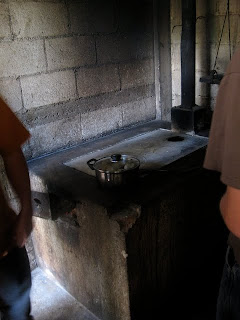We
interviewed 7 workers at Monica's Dad's paint factory. They were all men, about 25 to 50 years old and they live in or around the city. We explained that we are working on a water filter for university and that we have some questions and that we
want honest feedback even if they feel like they could be insulting our work (we got plenty of negative feedback, so this didn't appear to be an issue).
Our survey roughly went like this:
+ what do you use water for?
Generally, people
rinse food, clean clothing & floors, water plants.
Urban people drink bottled water. When it's unavailable they use
chlorine or boil it. Rural people lean towards boiling it.
+ where does your community's water come from?
We were amazed that every person
knew exactly where their water came from. I don't think average people in the U.S. have any idea or just a vague idea of a reservoir somewhere. These men were able to tell us exactly where the well or community tank was. They're more knowledgeable about their communities.
+ is your tap water safe to drink?
This led to a discussion of perception of water safety.
Rural people tend to think the water is safer than urban people. Almost everyone rinses fruits and vegetables with it. Urban people tend to drink bottled water and boil tap water when bottled is unavailable.
+ do you drink bottled water? how much do you spend on it? (if that didn't come up already)
This turns out to be a big cost and our filter could be 75% cheaper.
Emphasizing savings over purchasing bottled water is a likely marketing strategy.+ what kinds of illnesses has your family had in the past year?
This didn't produce much valuable information.
+ medical costs?
People get social health care so medical costs are usually minimal. However, feedback on state health was that you wait a long time and they're so busy that they often misdiagnose. Some people prefer the community health stand.
Emphasizing the savings in medical costs is not a good strategy.+ show model and ask for feedback
Main takeaways: Needs a
label with guarantee + instructions. Everyone
prefers the chunkier model vs. the slimmer one because it looks more robust. Should be in
packaging (cleanliness). Plastic preferred over metal.
+ what would you expect to pay for it?
If no answer, then we picked a number based on previous feedback and asked if they would pay that much
Additional questions we added after a few surveys:
+ What questions would you ask the salesman?
How to change the filter. Maintenance, reliability.
+ Would you want to change the filter yourself?
Yes, but would want to be shown the first time either in the store or at home. They don't want to pay someone to do something they can do.
+ Where would you expect to buy it?
Ferreteria (hardware store). They don't trust door-to-door salesmen which negates part of last year's project's marketing strategy. They would trust a d2d salesman only if they were already familiar with the product.













